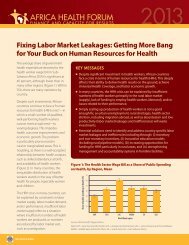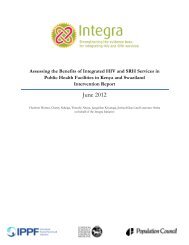ujh78
ujh78
ujh78
You also want an ePaper? Increase the reach of your titles
YUMPU automatically turns print PDFs into web optimized ePapers that Google loves.
Sex of head of household: The sex of the head of the child’s household made a difference to<br />
many indicators. The pattern was mixed, but living with a male head of household was commonly<br />
associated with higher percentages for deprivation in more instances than living with a female head of<br />
household. Living with a male head of household meant a higher percentage of receiving no vaccinations<br />
in 14 countries, having no primary or secondary education in 18 countries, and lacking medical advice for<br />
recent diarrhea and living in a house with a mud floor in two-thirds of countries. Living with a male head<br />
of household also meant a higher percentage of children using surface water (Benin, Ethiopia, Ghana,<br />
Guinea, Liberia and Madagascar); without access to any sanitation services (Senegal, Burkina Faso,<br />
Benin, and Ghana); without electricity (Senegal); and not enrolled in school (Benin, Burkina Faso,<br />
Cameroon, Nigeria, and Senegal). Living with a female head of household was most often linked with a<br />
higher percentage of stunting (in 11 countries); underweight (one-third of these countries); recent diarrhea<br />
(in 13 countries); and children not enrolled in school (Chad).<br />
Age of the head of household: As with sex, the age of the head of household made a difference<br />
to a number of deprivation indicators, but the pattern was mixed. For example, living with a head of<br />
household age 50 or older meant a greater percentage of stunting in 7 countries; underweight in half of the<br />
countries; no vaccinations in 17 countries; use of surface water (Cameroon, Kenya, Namibia and Nigeria);<br />
living more than a 15-minute walk from the primary water source (Namibia); living in a house with mud<br />
flooring (Namibia, Lesotho and Zambia); no electricity (Namibia and Uganda); no school (Benin,<br />
Burkina Faso, Ghana, Liberia, Madagascar, Mali, Niger and Tanzania); and dropping out of school<br />
(Burkina Faso).<br />
Trends in deprivations<br />
Over the past 13 years, a number of countries have made substantial progress in reducing the<br />
prevalence of deprivation in particular areas. Others have suffered setbacks.<br />
Food: Burkina Faso, Ethiopia, and Rwanda made the greatest progress in reducing stunting—by<br />
nearly eight percentage points or more. In Benin and Senegal, however, the situation worsened.<br />
Health: Many countries substantially decreased the percentage of children with no<br />
immunizations—Burkina Faso, Tanzania, and Uganda by over 30 percentage points. In contrast, the<br />
percentage in Zambia increased comparably. Burkina Faso, Kenya, Lesotho, Malawi, Nigeria, and<br />
Rwanda all decreased, by close to 20 percentage points or more, the percentage of children not receiving<br />
medical advice when they had diarrhea.<br />
Water: Burkina Faso, Ghana, Kenya, Madagascar, and Malawi decreased the percentage of<br />
children using ground water by more than five percentage points. In contrast, the percentage using ground<br />
water increased by nearly 29 percentage points in Ethiopia, and increases also were large in Rwanda and<br />
Zimbabwe. Senegal decreased by over 28 percentage points the percentage of children living more than a<br />
15-minute walk from their water source. Lesotho, Mali, and Nigeria made improvements of about 15 to<br />
19 percentage points.<br />
Sanitation: Ethiopia decreased the percentage of children with no access to sanitation facilities<br />
by nearly 25 percentage points.<br />
Shelter: In Mozambique the percentage of children living in homes with mud floors decreased by<br />
more than 15 percentage points. The percentage of children in homes with electricity increased by about<br />
10 to 12 percentage points in Ghana, Mozambique, and Senegal.<br />
Education: Burkina Faso, Ethiopia, and Zambia decreased the percentage not in school by 15 to<br />
almost 19 percentage points. Benin, Ghana, Kenya, Senegal, and Zambia reduced their school drop-out<br />
rates among children age 13 to 17 by at least six percentage points.<br />
xvi








